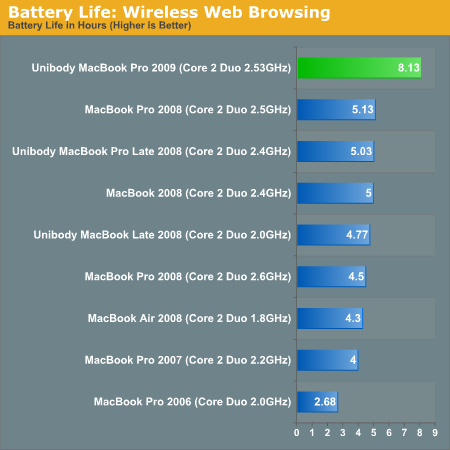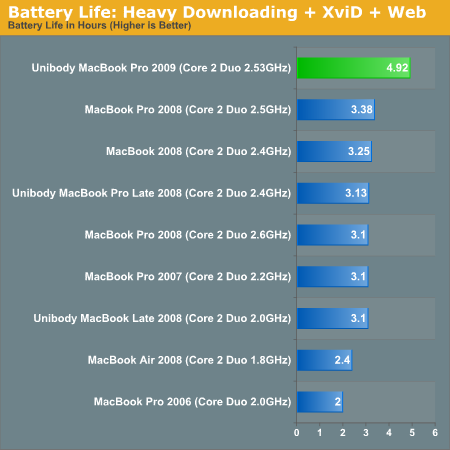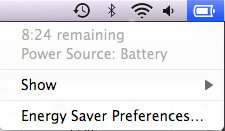Apple's 2009 MacBook Pro: Battery Life to Die For
by Anand Lal Shimpi on June 12, 2009 12:00 AM EST- Posted in
- Mac
The Best Battery Life I’ve Ever Seen
To find out how well the new lithium polymer battery does I ran my usual suite of Mac battery life tests. First up was my wireless web browsing test:
The wireless web browsing test uses the 802.11n connection to browse a series of 20 web pages varying in size, spending 20 seconds on each page (I timed how long it takes me to read a page on Digg and came up with 36 seconds; I standardized on 20 seconds for the test to make things a little more stressful). The test continues to loop all while playing MP3s in iTunes.
This is an extremely light test as none of the web pages have any flash ads, but it’s a valid test of very light wireless usage.

Eight, freakin, hours. I couldn't believe it. In my lightest test, the new 15-inch MacBook Pro lasted eight hours and eight minutes. That's with the screen at half brightness (completely usable) and no funny optimizations. The notebook is just playing music and surfing through a lot of my old reviews. There's no way this could be right. Maybe my test was too light?
I threw together another test just to make sure. The key flaw in my initial wireless web browsing test is that it none of web pages have any Flash on them. While constantly loading web pages will ensure the CPU can't go into deep sleep, Flash on the pages would make sure that the CPU utilization remains higher at all times. The next test I put together was this:
I strung together 8 reviews on AnandTech and put them each on a single page, images and all. I then scoured the web for big, animated Flash ads and added anywhere from 1 - 4 ads per page; all Flash. Each page is designed to forward to the next after 10 seconds and the loop continues indefinitely. On each machine I opened three Safari windows and pointed them at the first page in the sequence. In the background, once more, I had iTunes playing MP3s.
I found that CPU utilization varied from 5 - 35% during this test, which is about what I saw when I was actually surfing the web myself. The addition of Flash should make it more stressful, but it's still a fairly light usage test. My original web browsing test got us 8 hours, so what about this new one?
| MacBook Pro 2009 | MacBook Pro Late 2008 | |
| Wireless Web Browsing w/ Flash | 6.48 hours | 3.28 hours |
Six and a half hours, out of a 5.5 lbs notebook. For comparison, the older MacBook Pro could only manage 3 hours and 17 minutes in the same test. The new notebook lasted almost twice as long. Mathematically, this doesn't make sense. There's only a 46% increase in battery capacity, there shouldn’t be a ~100% increase in battery life...ever.
While the original web browsing test was using data from my original unibody MacBook Pro review, this second web test used a brand new MacBook Pro (purchased just weeks before this week's MacBook Pro announcement). The two notebooks had the same amount of memory (4GB), the older MacBook Pro had a slower CPU (2.4GHz vs. 2.53GHz) and a 7200RPM hard drive but the differences shouldn’t account for an extra 54% increase in battery life.
Apple must have done more than just increase battery capacity in the new MacBook Pro. My third test continues to support my findings. This is my heavy workload benchmark.
For this benchmark I'm downloading 10GB worth of files from the net (constant writes to the drive), browsing the web (same test as the first one) and watching the first two episodes of Firefly encoded in a 480p XviD format (Quicktime is set to loop the content until the system dies).
The older MacBook Pro managed 3.25 hours in this test. The new one? Just under 5:

That's a 51% improvement in battery life. It's close enough to the max theoretical 46% improvement for me to think that the significant gains in wireless web browsing are due to improvements in idle power optimizations. It's possible that all of the components in the new MacBook Pro have been optimized for lower voltages at idle.
The battery tests are repeatable however. I saw anywhere from a 50 - 100% improvement in battery life over the old MacBook Pro. Given the increase in battery capacity alone, you should see no less than a 46% increase in battery life. Exactly what is accounting for the expanded life above and beyond that, I'm not sure.
Either way, Apple's 7 hour claim is well within reason. For light workloads, even on WiFi, you can easily expect 6.5 - 8 hours out of the new 15-inch MBP. As I write this article on that very system I'm told that I have nearly 8.5 hours left on my charge. If you do a lot of writing on your notebook, the new MBP is exactly what you'll want; it will easily last you on a cross-country flight if you need to get work done.

I think I've just found my new writer's companion
My heaviest workload delivered just under 5 hours of battery life, a figure that the old MBP could only attain while running my lightest workload. This thing rocks.
I also have to commend Apple for delivering realistic battery life specs on its laptop. While 7 hours definitely involves a light workload, it is more than attainable as I've shown in the tests above.
A quick search shows that even Dell's Studio 15 only offers a battery rating of up to 5.5 hours. It looks like, once again, other notebook makers will have to play catch up to Apple in this department.










113 Comments
View All Comments
JimmiG - Friday, June 12, 2009 - link
Yeah, a few quick battery tests under Windows would be nice. From what I've read, Macbooks only have excellent battery life under OSX. Under Windows, they are like any other PC with a 50 - 90whr battery.Sadly this seems to be one aspect Microsoft won't "fix" with Windows7 - although I guess it's mostly the fault of hardware manufacturers releasing poorly optimized drivers and firmwares...
solipsism - Friday, June 12, 2009 - link
• The 13” MBP has a screen that is now equivalent to the 13” MBA. The change apparently happened a month or two ago, silently. People on some Apple-based forums were reporting that their new MB had a screen like their MBA/MBP or that it was unlike their previous MB. This is one reason that the rumour of the MB going Pro was likely.• The 60W power supply is indeed for the low-end 15” MBP with 9400M. Apple’s MBP tech specs list both for their 15” mode: "60W or 85W MagSafe Power Adapter with cable management system"
aliasfox - Friday, June 12, 2009 - link
I haven't confirmed this, but at WWDC it was announced that the new 15" has 60% better color gamut than the old one, and that the new 13" MBP matches the new 15" screen. A 60% increase in color gamut suggests a move to RGB LED, same as the nice top end Dell and Acer screens that Anandtech reviewed a couple of months ago. The other reason the MBP is now "Pro" could be the re-inclusion of Firewire. Yay!iwodo - Friday, June 12, 2009 - link
If, and only IF, they are using RGB LED ( which i highly doubt it, honestly )Then Macbook Pro would be a Bargain to buy for its price.
I also wonder why they aren't advertising RGB LED if they are indeed using it.
The only reason i think the increase of 60% Gamut may be of Better Panel. However i also know there are no Panel Tech that could increase Gamut by 60%...
Anybody shine some light on this?
PlasmaBomb - Saturday, June 13, 2009 - link
A site that reviews notebooks mentions the +60% Gamut, but doesn't mention RGB LED that I can see. Although the review is still ongoing.santala - Friday, June 12, 2009 - link
I recently took apart an old Macbook white battery and it was already using these thin cells and not the traditional round ones. The battery was dead and at least a year old, more likely two or three, perhaps as old as the first Intel Macbooks.So the story about "new" technology is simply not true. I would argue that Macbooks have always used these thin battery cells, they're just able to cram more of them (or bigger ones) into the things once they don't have to worry about the part about the being removable.
santala - Friday, June 12, 2009 - link
And obviously the old ones were Li-Ion.PlasmaBomb - Friday, June 12, 2009 - link
You are confusing a rectangular battery with rectangular cells.I presume your battery looks like this -
http://pics.bbzzdd.com/users/PlasmaBomb/Mid_2006.J...">http://pics.bbzzdd.com/users/PlasmaBomb/Mid_2006.J...
Which is indeed a rectangular lithium ion pack. It will however contain cylindrical cells. Also lithium ion != lithium polymer.
RikkiTikkiTavi - Friday, June 12, 2009 - link
Apple simply got their facts wrong here. Lithium ion batteries can be made in cylindrical forms, but are usually flat.Scientific explanation (from yours truly, an aerospace engineer with some, limited experience on the matter):
Conventional batteries (that is everything up to and including Ni-MH cells) work by dissolving metal in a solution, and then restoring it to recharge. While lithium has excellent properties to store energy, recharging wouldn't work, for reasons I will not elaborate upon here (ask if you really want to know).
So instead of forming a lithium metal grid, in the recharged state the lithium ions are stored in a different medium, often a porous Graphite grid.
Graphite is most easily cut into slim slices, and looses a lot of its ion-storing capacity when forced into a cylindrical form.
Even if you don't use Graphite, you still have the problem, that, in order to achieve sufficient power density to supply a laptop, you have to expand the working surface of your battery by forming layers. These have to be of equal capacity, or else the power density would drop before the unit is completely discharged. No problem with flat layers, but in a cylindrical cell, you'd have to make the inner layers thicker and the outer layers thinner, to keep the capacity constant, which creates numerous problems.
Yes, cylindrical Li-ion cells exist, but no, they are not common.
ncbill - Saturday, June 13, 2009 - link
Many popular li-ion cells are cylindrical.The 18500 Li-Ion cylindrical cell is very common and widely used.
For anything from laptop batteries to the Tesla Roadster.